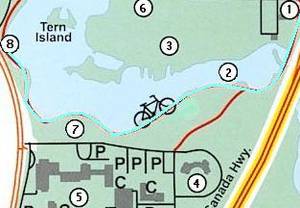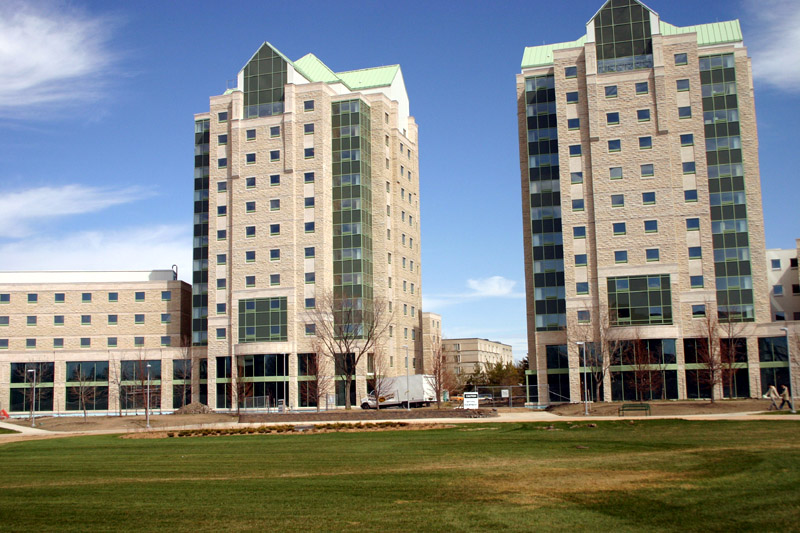1.38 kilometers - 20 minutes
 Following the Wascana Centre Bike path, this walk travels alongside the northern section of the campus of the University of Regina. There are also other areas of Wascana Centre observable from this walk.
Following the Wascana Centre Bike path, this walk travels alongside the northern section of the campus of the University of Regina. There are also other areas of Wascana Centre observable from this walk.
The University of Regina is a partner and one of the founding agencies of Wascana Centre Authority and helps to fulfill one of the purposes of Wascana Centre - the enlargement of educational opportunities. Wascana Centre is a great place to learn so spend some extra time and take a look around, you’ll be surprised at the knowledge you can gain.
- Starting at the Wascana Greenhouses, located on Assiniboine Avenue in Douglas Park, the double lane road ahead is a combination of the Trans-Canada Highway and the Regina Ring Road. The Ring Road directs the east and west bound routes of the Trans-Canada Highway around our city.
Following the bike path south across Wascana Marsh, one can see across the highway to the former Plains Health Centre. The building has since become the campus of Saskatchewan Polytechnic.
- Wascana Lake between Albert Street and Broad Street was excavated in the 1930s and again in 2004, but Wascana Marsh east of Broad Street has been designated as a nature reserve, thus it has been allowed to flourish in its natural state. In 1913 the City of Regina declared it a Game Preserve. When Wascana Centre was developed in 1962, the lake and surrounding area was included as the Wascana Waterfowl Park.
- Continuing southwest along the bike path, you are able to view the First Nations University of Canada, designed by aboriginal architect Douglas Cardinal. The FNUC was established in 1976 as the Saskatchewan Indian Federated College (SIFC) through a federal partnership with the University of Regina. The building opened in 2003 at a cost of $30 million and is the only First Nations controlled university in Canada. The University is independently administered offering post-secondary education in a culturally supportive First Nations’ environment.
Along the shore on the north side of the lake, is the Habitat Conservation Area. This area has been set aside as a nature reserve. Open to the public year round, this facility is used by school groups for outdoor education on the upland habitat of a prairie marsh. Guided tours of this area are available throughout the summer, for more information call Wascana Centre.
- This path runs along the north edge of the University of Regina main campus. Construction began on the main campus in 1965. This University was initially established as the Regina campus of the University of Saskatchewan in 1934, but became an independent institution on July 1, 1974. The first two buildings are Luther College and Campion College respectively. Luther has a student residence housing 217 people. Both of these colleges are affiliated with the University of Regina and accredited classes are offered through these colleges. In behind these buildings are the Paskwaw and Wakpa residences which were completed and opened in 2016.
The next building to the west is the Language Institute. The Language Institute has the Bilingual Studies Centre and a Summer Centre for International Language students.
The two large tower buildings behind the Language Institute are new residence buildings that were completed in 2004 at a cost of $38 million. In addition to 693 bedrooms in dormitory and apartment style residences, the two 12 storey residential towers house administrative areas, student common areas, study areas, meeting and conference space and other support facilities.
- North of the Waterfowl park nature area is Wascana Hill. Try out the trails! You might learn how to cross country ski or mountain bike!
- The sculpture titled “Mind’s Garden” was designed in 1994 by Regina artist Joe Fafard. This visually rich and thought provoking work is made of cast bronze and weighs approximately 3600 kilograms. “Mind’s Garden” was erected in October 1999 and is on loan from the artist.
The brown building west of the Language Institute is the Administration-Humanities building or the Ad-Hum as the students, alumni and faculty refer to it. This building is home to the administrative offices of the University which include the business office, the office of the Registrar and the office of the Dean. The Ad-Hum is where you will find the ‘pit’, a sunken area on the ground floor used for studying and meeting friends.
Set back from the road is the Library Building which was designed to be the official entrance to the University of Regina.
The building on the corner is the Classroom Building. This building houses lecture theatres, classrooms and Faculty offices.
- Continuing North on the bike path brings you closer to the marsh waters. In virtually all seasons many different types of waterfowl can be viewed from this location. Heading toward the corner of Lakeshore Drive and 23rd Avenue you will see a graduated wooden slope following the boardwalk. This shoreline is prone to soil erosion and the wooden slope was constructed to combat the problem.




with our newsletter